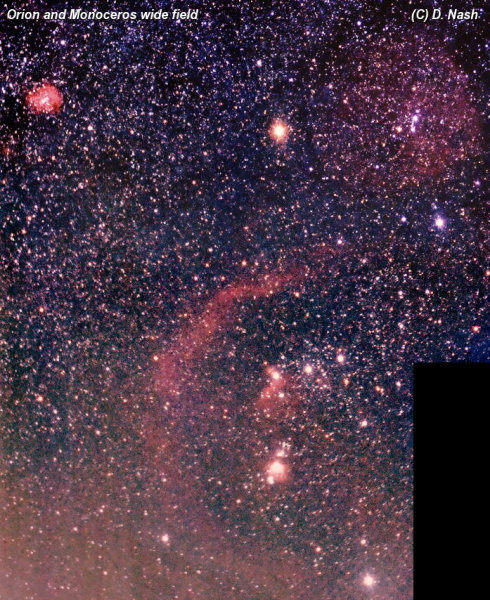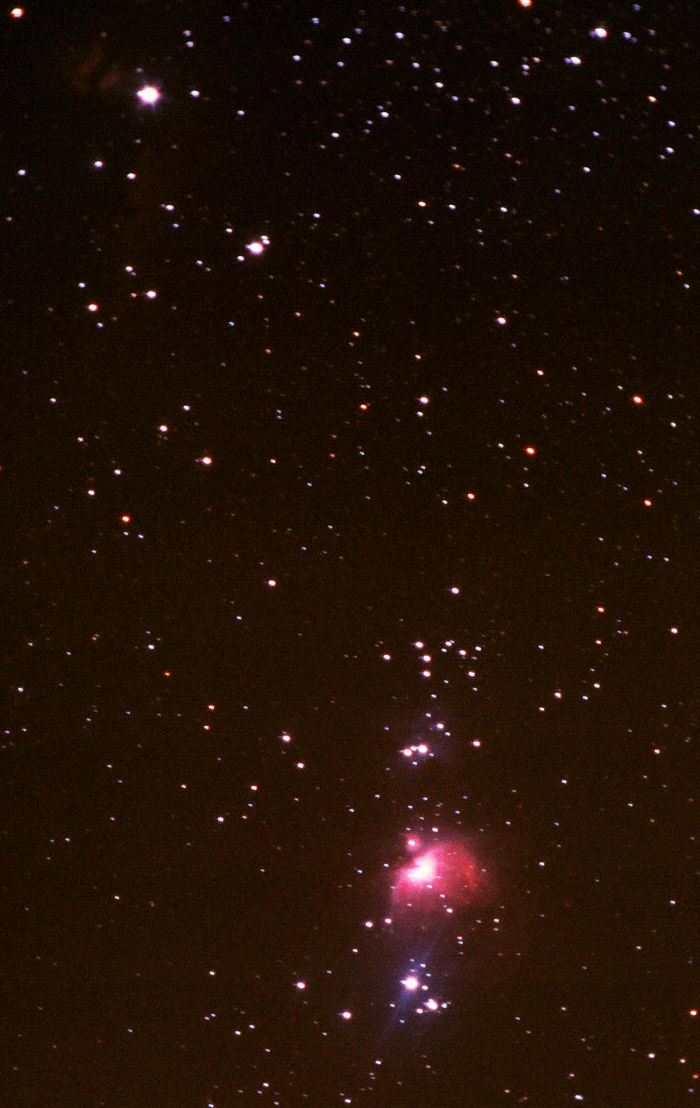| Home | ||||||
| Orion | ||||||
| HOME Best Lunar Planets Deepsky Misc Equipment Techniques Links |
| Galaxies Nebulae Star Clusters Constellations Multiple Stars |
| This page shows the constellation of Orion -- the hunter. This constellation is prominent in the South during the winter. It is located on the celestial equator so is visible from practically everywhere in the world. This means it is not particularly high in the sky from where I live in England, although it is still very observable!
Orion is one of the favourite constellations for amateur astrophotographers, as in addition to containing the famous Orion Nebula, it also contains one of the most popular deep-sky objects, the dark nebula known as Barnard 33, or more commonly, the Horsehead. |

|
|
|
The picture above is a wide-field image of Orion and part of neighbouring Monoceros. It is a stack of four 20-minute exposures on Elite Chrome 200 film with a 50mm lens at f/4. The film processing was pushed 2 stops to bring out the faint nebulosity in this region. The large arc of red around Orion is known as Barnard's loop. It was discovered around 1900 by E. E. Barnard on long exposure, although it is suspected that William Herschel discovered it in 1786. This object may be a supernova remnant. The very large red nebula around the group of stars at the top right of this picture (Orion's head) is called Sh2-264. See HERE for more details. In the middle of the picture you can see the three stars of Orion's belt, with the Flame nebula immediately adjacent to the leftmost star, Alnitak, and the Horsehead dark nebula in the red area below that star. Below is the famous Orion nebula, M42, the brightest part of the Orion cloud, a huge area of red gas covering most of the constellation. At the top left of the picture, in the constellation of Monoceros, is the Rosette nebula, a large red emission nebula with an open cluster (NGC2244) embedded within it. | |

|
|
|
The bright red nebula, plus the stars above and below in the lower part of this picture form Orion's Sword. The red nebula is of course M42, the Great Orion Nebula, and the small detatched part above it has the designation M43. M42 is a cloud of gas illuminated by the heat of various stars embedded within it, most notably the multiple star system known as The Trapezium. Four stars are easily visible in the eyepiece, and more are detectable using a camera or higher power telescope, although with the long exposures necessary to capture the fainter parts of the nebula, these stars will be overexposed, and hence are not visible in this picture. The nebula contains many star forming regions where new stars are being born, and the Hubble space telescope has also detected Proto-planetary disks, where planets form around stars.
At the top-left of this picture is a bright star -- this is Sigma Orionis, or Alnitak, the leftmost star of Orion's belt. Alnitak is a binary star and the primary is a bright supergiant. To the upper-left of Alnitak in the picture is a region of nebulosity bisected by dark lanes, which is called the Flame Nebula. Below Alnitak is a reddish area of gas, superimposed on which is a black area called the Horsehead Nebula. This picture was taken using a 270mm lens set at f/4.0. The film, which was Fuji Provia 400F, was exposed for 15 minutes. The processed film was scanned and the image enhanced using The Gimp. |
|
| to top | home |
 |
|
| All text and images copyright and may not be used without permission |
|